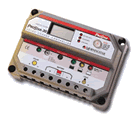 A
charge controller, also known as a
solar regulator, is a regulator
that goes between the solar panels
and the batteries. A charge controller
is used to regulate the voltage and
current coming from the solar panels and going to the
battery. As the input voltage from the solar array rises,
the charge controller regulates the charge to the batteries
preventing any over charging.
A
charge controller, also known as a
solar regulator, is a regulator
that goes between the solar panels
and the batteries. A charge controller
is used to regulate the voltage and
current coming from the solar panels and going to the
battery. As the input voltage from the solar array rises,
the charge controller regulates the charge to the batteries
preventing any over charging.
Sizing a Controller:
Charge controllers are rated and sized by the array
current and system voltage. Most common are 12, 24,
and 48 volt controllers. Amperage ratings run from 1
amp to 60 amps, voltages from 6-60 volts.
To size your controller, here
is an example:
If one module in your 12-volt system produces 7.45 amps
and two modules are utilized, your system will produce
14.9 amps of current at 12 volts. Because of light reflection
and the edge of cloud effect, sporadically increased
current levels are not uncommon. For this reason we
increase the controller amperage by a minimum of 25%
bringing our minimum controller amperage to 18.6. A
20-amp controller is as close a match as possible, however
there is no problem going with a 30-amp or larger controller,
other than the additional cost. When selecting a solar
regulator, it's important to look ahead - if you think
you'll be adding to your system, it pays to buy a regulator
rated as high as possible, which can save you money
when you add additional solar panels.
NOTE: the solar regulator should be capable of handling
the total short circuit current of a solar panel.
Generally, there is no need for a charge
controller with the small maintenance, or trickle charge
panels, such as the 1 to 5 watt panels. A rough rule
is that if the panel puts out about 2 watts or less
for each 50 battery amp-hours, then you don't need one.


 A
charge controller, also known as a
solar regulator, is a regulator
that goes between the solar panels
and the batteries. A charge controller
is used to regulate the voltage and
current coming from the solar panels and going to the
battery. As the input voltage from the solar array rises,
the charge controller regulates the charge to the batteries
preventing any over charging.
A
charge controller, also known as a
solar regulator, is a regulator
that goes between the solar panels
and the batteries. A charge controller
is used to regulate the voltage and
current coming from the solar panels and going to the
battery. As the input voltage from the solar array rises,
the charge controller regulates the charge to the batteries
preventing any over charging.


